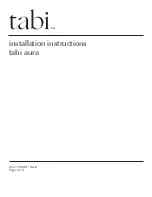
h/e Apparatus and h/e Apparatus Accessory Kit
012-04049J
2
®
Planck's Quantum Theory
By the late 1800's many physicists thought they had ex-
plained all the main principles of the universe and discov-
ered all the natural laws. But as scientists continued work-
ing, inconsistencies that couldn't easily be explained be-
gan showing up in some areas of study.
In 1901 Planck published his law of radiation. In it he
stated that an oscillator, or any similar physical system,
has a discrete set of possible energy values or levels; en-
ergies between these values never occur.
Planck went on to state that the emission and absorption
of radiation is associated with transitions or jumps be-
tween two energy levels. The energy lost or gained by the
oscillator is emitted or absorbed as a quantum of radiant
energy, the magnitude of which is expressed by the equa-
tion:
E = h
ν
where
E
equals the radiant energy,
ν
is the frequency of
the radiation, and
h
is a fundamental constant of nature.
The constant,
h
, became known as Planck's constant.
Planck's constant was found to have significance beyond
relating the frequency and energy of light, and became a
cornerstone of the quantum mechanical view of the suba-
tomic world. In 1918, Planck was awarded a Nobel prize
for introducing the quantum theory of light.
The Photoelectric Effect
In photoelectric emission, light strikes a material, causing
electrons to be emitted. The classical wave model pre-
dicted that as the intensity of incident light was increased,
the amplitude and thus the energy of the wave would in-
crease. This would then cause more energetic photoelec-
trons to be emitted. The new quantum model, however,
predicted that higher frequency light would produce
higher energy photoelectrons, independent of intensity,
while increased intensity would only increase the number
of electrons emitted (or photoelectric current). In the
early 1900s several investigators found that the kinetic
energy of the photoelectrons was dependent on the wave-
length, or frequency, and independent of intensity, while
the magnitude of the photoelectric current, or number of
electrons was dependent on the intensity as predicted by
the quantum model. Einstein applied Planck's theory and
explained the photoelectric effect in terms of the quantum
model using his famous equation for which he received
the Nobel prize in 1921:
E = h
ν
= KE
max
+ W
O
where
KE
max
is the maximum kinetic energy of the emit-
ted photoelectrons, and
W
O
is the energy needed to re-
move them from the surface of the material (the work
function).
E
is the energy supplied by the quantum of
light known as a photon.
The h/e Experiment
A light photon with energy
h
ν
is incident upon an elec-
tron in the cathode of a vacuum tube. The electron uses a
minimum
W
O
of its energy to escape the cathode, leaving
it with a maximum energy of
KE
max
in the form of kinetic
energy. Normally the emitted electrons reach the anode of
the tube, and can be measured as a photoelectric current.
However, by applying a reverse potential
V
between the
anode and the cathode, the photoelectric current can be
stopped.
KE
max
can be determined by measuring the mini-
mum reverse potential needed to stop the photoelectrons
and reduce the photoelectric current to zero.* Relating
kinetic energy to stopping potential gives the equation:
KE
max
=
Ve
Therefore, using Einstein's equation,
h
ν
=
Ve
+
W
O
When solved for
V
, the equation becomes:
V = (h/e)
ν
- (W
O
/e)
If we plot
V
vs
ν
for different frequencies of light, the
graph will look like Figure 2. The
V
intercept is equal to
-
W
O
/e
and the slope is
h/e
. Coupling our experimental de-
termination of the ratio
h/e
with the accepted value for
e
, 1.602 x 10
-19
coulombs, we can determine Planck's
constant,
h
.
Background Theory
*NOTE:
In experiments with the PASCO h/e Ap-
paratus the stopping potential is measured directly,
rather than by monitoring the photoelectric current.
See the
Theory of Operation
in the Technical Infor-
mation section of the manual for details.
Figure 2. The graph of V vs.
ν
νν
ν
ν
Stopping
Potential
V
Frequency
ν
Slope
= h/e
Содержание h/e Apparatus
Страница 2: ......
Страница 14: ...h e Apparatus and h e Apparatus Accessory Kit 012 04049J 10 Notes...
Страница 22: ......







































